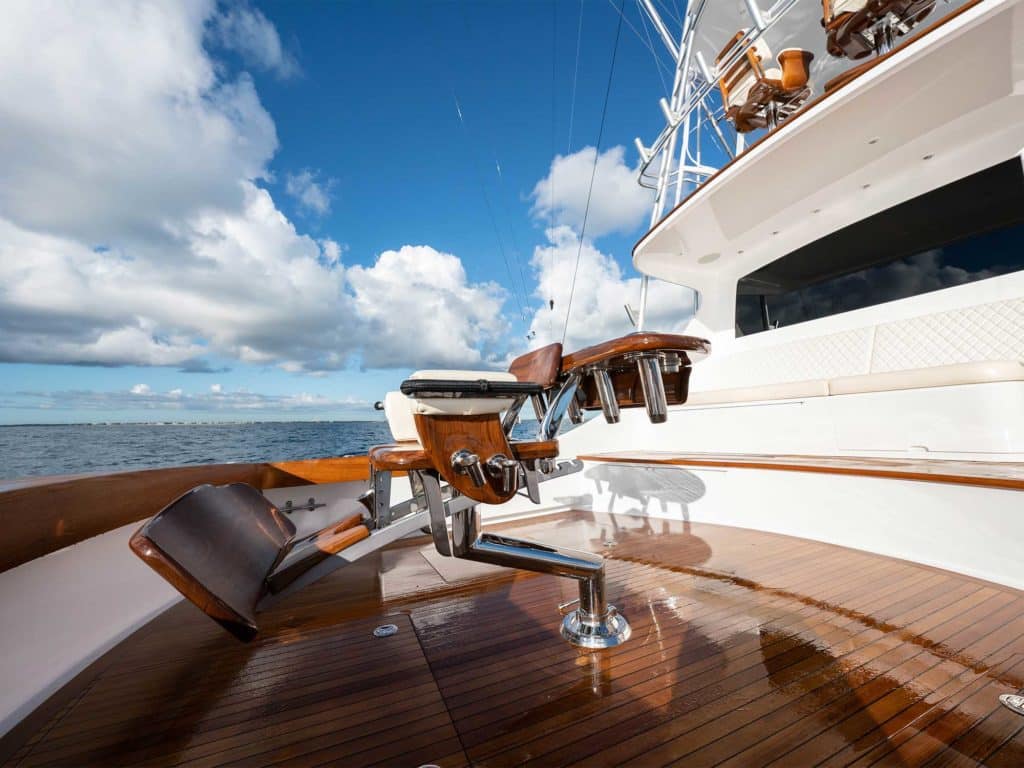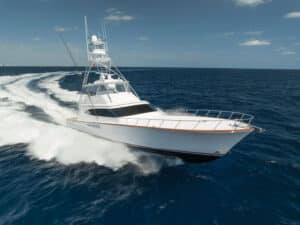
Nothing gets me more excited than having an opportunity to review a new custom build, and this one just happens to be the new flagship of Garlington: a 71-footer called Miss Behavin. Sequential to the immense success of the 61, the 71 was designed to be a globe-trotting fish chaser, and it shows in every way. As I walked down to the dock on a crisp October morning in Stuart, Florida, Miss Behavin sparkled in the sunlight. She just screamed custom: large cockpit, wonderfully done teak and metal work, and so clean that you need sunglasses just to look in her general direction. My day was dedicated to her, thankfully.
I quickly climbed aboard to meet builder Peter Landeweer and got settled in for our sea trial. As we idled out of the Manatee Pocket and into the St. Lucie River, Landeweer pushed the throttles forward on a track heading offshore. The 71 quickly hopped up on plane and screamed eastbound as our 40-foot chase boat struggled to keep up.
Watch: We show you how to rig one of the best baits for blue marlin: the swimming mackerel.
Historically, Garlington Yachts are built with Corecell foam, allowing it to remain lightweight because the foam absorbs only 1 percent of its weight in water over its entire lifetime. In addition to the foam, the hulls are laid up with a combination of fiberglass, Kevlar, and carbon fiber to ensure it is both strong and agile. Garlington takes pride in its construction method, one that results in not only a durable and rigid final product, but a quiet one as well.

Cockpit and Bridge
The star of the show in this build by far is the cockpit. The 71 was designed to be a worldwide fish-chasing weapon. Not only is the cockpit massive, but under each hatch and behind each door are more surprises. Straddling the Release Marine fighting chair are four in-deck hatches. Under the portside forward hatch is a generous livewell; nine tuna tubes are located under the aft hatch. On the starboard side, there are two fish boxes direct-plumbed so that the chipper ice goes directly into the box. On the portside mezzanine step, there are two freezer boxes and a centerline refrigerated step; behind the bridge ladder, there is a full-size tackle center.
The mezzanine seating features diamond-stitched upholstery and enough seating for the entire team to take a load off. And for those sweltering Costa Rican days offshore, air-conditioning vents were installed over the lounge to blow cool air downward.

As you climb the teak ladder steps up to the flybridge, you are greeted by dual Release Marine helm chairs mounted on a molded step. The centered captain’s chair sits behind a custom teak helm pod with single-lever controls. Four Garmin MFD screens are flush-mounted behind an acrylic panel, with a row of sleek toggle switches tucked beneath one of the screens. A Furuno Omni sonar controller is located in the portside flip-up box, and information can be displayed on any of the four screens. The MAN engine-data displays and VHF radios are located in the drop-down box above.
Overhead in the hardtop are a pair of teaser reels as well as an additional aft-facing Garmin screen. Bench seating is located on the starboard side, and a large, comfortable wraparound seat is forward of the helm. A bar-quality ice machine is located in the forward corner, and additional storage is found under all of the helm seating.

When you climb the Bausch tower, you will notice a clean but simple station layout: a single Garmin display inside the pod box, electronic engine controls, and dual analog tachometers. Purity at its finest.
Interior
As you enter the salon, bright, modern tones proliferate your senses with a white U-shaped sofa, matching ottoman and starboard-side dinette, and a motorized pop-up 55-inch television is hidden within the sublime teak cabinetry. The galley is complemented with dark granite countertops, a four-burner Dacor cooktop and Sub-Zero refrigeration drawers. If you pay close attention to the ash and teak flooring, you’ll notice a cutout in the floor at the entrance of the galley. Garlington installed a hidden access door to the engine room, which is great for passing up bulk items.

Designed with a four-stateroom, three-head layout, the boat has plenty of room to stretch out when being used as a home away from home while traveling. Miss Behavin’s master stateroom is located portside, aft, with a full king-size bed that features specifically designed storage underneath to house a set of spare props. An elegant custom makeup desk with a swing-out stool and teak-faced, cedar-lined hanging closets are among the highlights here, and the master head presents with granite countertops, ash and teak flooring, and a large stand-up shower with a molded seat.
Just forward in the companionway, you will find a full-size washer and dryer on the port side behind a custom foldout door that allows full access to both machines. A VIP stateroom is located forward, with the bunks oriented in a stacked-V configuration—a lower double bunk to starboard and a single upper bunk to port—and a private, full head is located aft on the starboard side of the stateroom. On the starboard side of the companionway are two double-single bunk rooms with a shared head.

Engine Room and Performance
In the belly of this dissident beast, twin MAN V12-1900s are set in the center of a massive engine room. A pair of 25 kW Northern Lights generators orients aft, and the climate-control components and a toolbox are mounted on the forward shelf. There is also an abundance of space forward of the engines, which would be great for storing spare parts or nonperishable goods. Centerline finds an MC2 X19 Quick gyro, and an ElectroSea Clearline electro-chlorination system is also installed.
On that brisk morning, the Atlantic seas were a soothing 1 to 2 feet, with the north wind barely wafting at 5 to 7 knots. Within a few days, Miss Behavin would be headed to Costa Rica via the Panama Canal on her own bottom.
Read More: Learn to make full use of a stand-up harness here.
As Landeweer pushed the throttles forward, I was impressed by how quick the MANs responded. They were quiet, and the acceleration was noteworthy. We got up to a slow cruising speed of 29 knots, with a 70 percent load at 1,700 rpm, burning 50 gph per side. As we pushed forward, an 80 percent load at 1,900 rpm burned 63 gph per side at a speed of 33 knots. But when given the chance to fully stretch her legs, the 71 turned up to 2,350 rpm at 100 percent load, burning 94 gph per side, for a top end of 41 knots.
When keeping in mind the owner’s goal of fishing many days off the Central American coast, this is indeed the perfect power package for this boat: decided fuel economy and range, with plenty of power available to get you home in a hurry should the situation arise. Buena suerte, señorita, and try to behave yourself.
Garlington Yachts 71 Specs
- LOA: 71′
- Beam: 19’9″
- Draft: 5’5″
- Displ: 94,000 lb.
- Fuel: 2,250 gal.
- Water: 300 gal.
- Power: MAN V12-1900; 1,900 hp
- Gear/Ratio: ZF/2.24:1
- Propellers: Veem, 5-blade
- Paint: Awlcraft 2000, Ice Blue (hull)
- Climate Control: Dometic




This article originally appeared in the April/May issue of Marlin.







